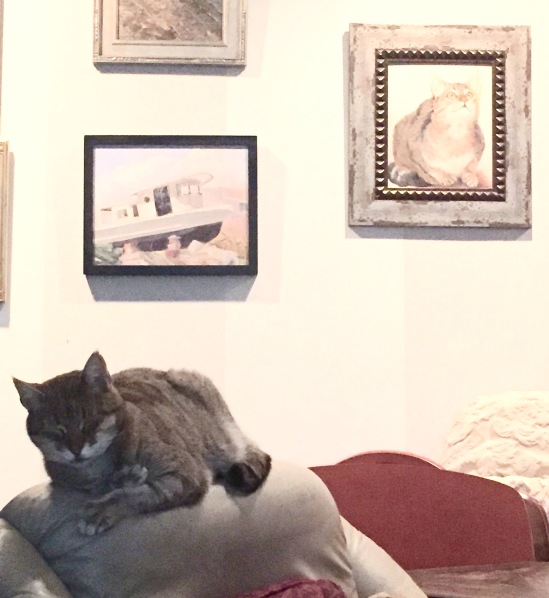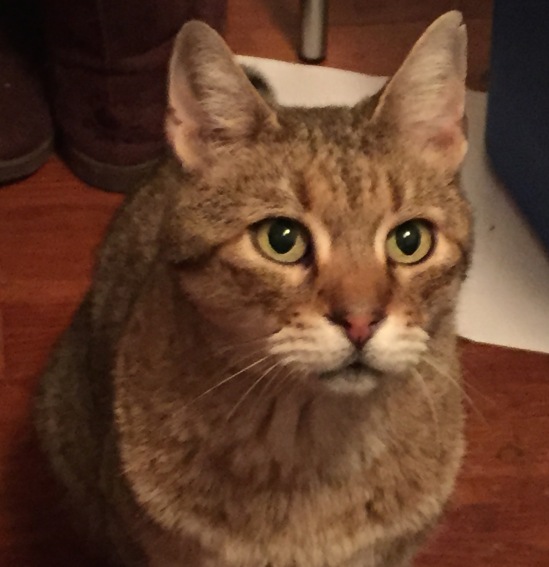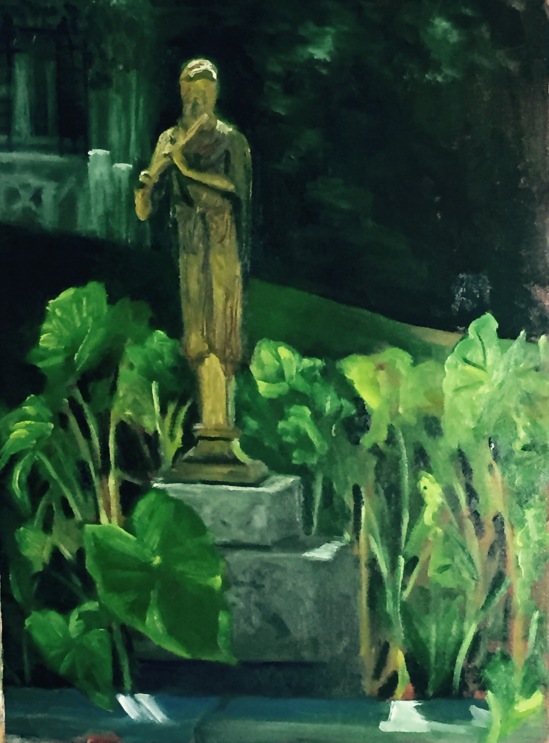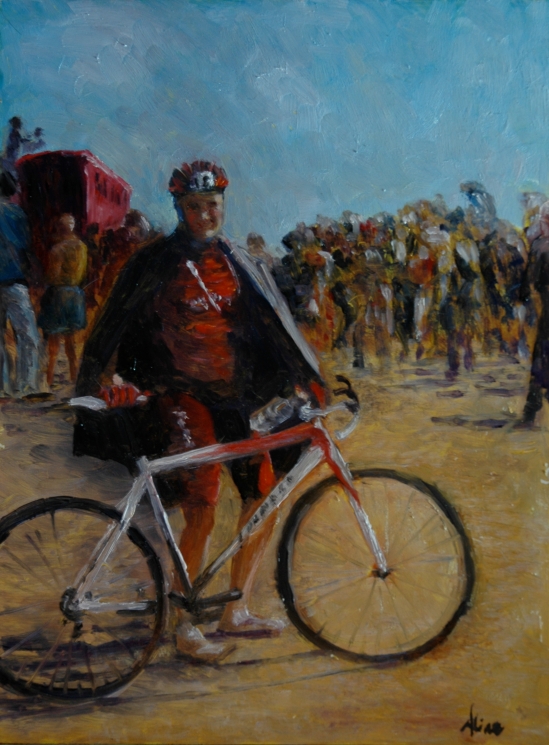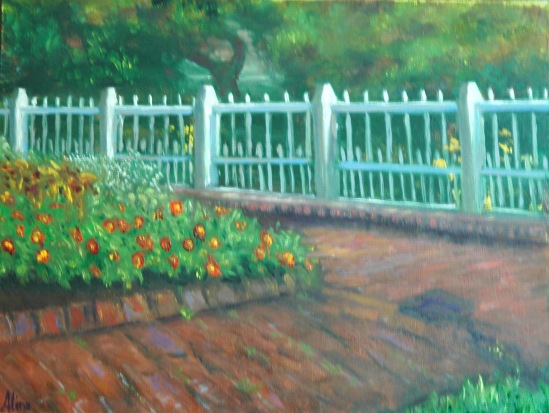I have taken the equivalent of a sabbatical, I guess. The beauty of being one’s own boss, one can do that sort of thing on a whim, with only your friends and followers to answer to. I went on that wild weekend to Acadia last fall, wherein I diligently painted at least two paintings every single day, and then I just lost interest. Except for a few pet portrait commissions, I did not pick up a paintbrush all winter. I did draw diligently, every Saturday at our life group sessions. And last weekend I made the annual pilgrimage to Bartlett so as to make the end of winter, forcing myself out in the open to paint en plein air.
Today, therefore, I am here to report on a few of the drawings and all four of the Bartlett paintings. Which first? I just now photographed the four paintings so I’ll start with them. Only the last one was actually painted in the Town of Bartlett, near the Inn where we have always stayed. The first one is from our way up. I went up with Sharon Allen, and she needed to make a few stops in Tamworth, where she had doped out some good views during a week-long event just finished. I decided on a close-up view of a small waterfall, thinking to explore shapes and colors–something out of the box since I should have grown less prone to habits. I tried, I really did, but if there’s anything outside the box here, I don’t see it manifested.

Tamworth Waterfall
I worked and reworked the colors found in and under the water until I just about drove myself crazy. Why, if I apply the matching color in the correct spot, doesn’t the water resemble nature? I concluded that it has to be done in layers–simply not possible with oils en plein air. So when I got home after the weekend, I tried again to duplicate what I remembered. No, a layering technique can’t be superimposed. Pause for reflection: Do I really want to be a super realistic painter? My forte, if I have one, had been speed and spontaneity.
Onward and northward: The next day after our hearty breakfast at the Bartlett Inn, we debated where to go to paint. There were seven of us, and although we never all of us agree on location, we like to keep tabs on where we are all heading–except for Byron Carr, who still goes for obscure, hard to navigate spots that none of the rest of us can access. First stop for four of us was the alpaca farm in North Conway. The owner suggested that we set up behind the house and barn, which was downhill and away from the livestock. That was OK with me as I had no idea what kind of subject would snap me out of my lethargy. It turned out that a building was a good choice. We had good light when we started and I tried to keep it in mind as I filled in the shadows. The part that pleases me the most, however, is the accumulation of stuff piled in front of the barn. I decided I would depict the piles as piles, with just enough articulation to suggest the nature of the stuff comprising the piles. I hope you get that.

Farm in North Conway
In the afternoon, we headed West to the Franconia Notch–I don’t remember what the reasoning was. It is a far way to go since Bartlett is South of the Crawford Notch, and you can’t get to Franconia Notch from there without first driving North. In between is national forest timber and trees and maybe a few logging roads, and somehow when you get to Franconia Notch, there are mountains all around, extending back to Crawford Notch. Hmm. That does seem to compute. Anyway, we finally settled on a spot on Profile Lake, near the area where our iconic mountain man profile once lived. (It crumbled quite a few years ago but we still pay homage.) Like I did in Tamworth, I decided to focus in on a small patch of stream and shadows and reflections and, most importantly, sunlight glinting off the water and trees. Water layers again, but I was more worried this time about the drama of shadow and light. A passerby complimented me on the expressiveness of the painting, and I thought, yes! I’m getting it. When I got it home, however, I decided to simplify the composition by bringing the water down to the bottom of the painting, wiping out the sandy shore. I did a great job on the sand, but it was “de trop”, as a Frenchman might say.

In Franconia Notch
Rain was forecast for the next two days of our weekend. When the sun was nevertheless visible in the morning, we hurried to the most local of possibilities, a road that runs along Saco River in the Town. But there is no river in my painting. A rivulet feeder into the Saco is implied by the presence of rails on a road, which takes a sharp curve to avoid running into a white house. Not exactly a view that dreams are made of. But I thought I had a good composition and hoped I could present the elements–road, trees, railing and house–in such a way as to draw the eye. It was a good exercise but did not result in a painting that anyone is going to want to put on their wall. (If I’m wrong about that, it’s yours!)

House at the Curve in the Road
I promised some kind of narration about the drawings. I wouldn’t have thought to mention them at all but for a Call for Art coming from Exeter for representations of nudity. I spread a bunch before me and selected five to photograph and three to submit to the Call. All three were accepted, so then I had to get them framed. Shot myself in the foot there. The exhibit was very nice, very short and open only on Saturdays for the duration. Now I have three framed nudes (beautifully framed, thank you Grace of Creative Framing Solutions) looking for homes. The price for each is $150, or best offer. Each is roughly 11×17 not including mat and frame.
. . . Myself. Still trying to find Myself, meaning what kind of art is in me? I have been struggling with this polyglot art for many years now. What are the common strands? Representational in subject matter. Impressionistic in style. I feel urges, to break free of representational, to jump into a bath of expressionistic paint. Yet when I am confronted with the specific task, I revert to representational impressionistic images. Stay tuned. Something might change.
Thanks for staying with me.



































